“The Santa Teresa Tram (Bonde de Santa Teresa) is a historic tram line in Rio de Janeiro, Brazil. It connected the city centre with the primarily residential, inner-city neighbourhood of Santa Teresa, in the hills immediately southwest of downtown. It was mainly maintained as a tourist attraction and is nowadays considered a heritage tramway system, having been designated a national historic monument in 1988. The line has a very unusual gauge: 1,100 mm (3 ft 7 5⁄16 in). The main line is 6.0 kilometres (3.7 mi) long. Having run continuously since its opening in 1877 until 2011, it is one of the oldest street railway lines in the world and having been electrically powered since 1896, it is the oldest electric railway in all of Latin America. It is also the only remaining metropolitan tram system in Brazil. The only other original tram systems in the country to have survived past 1971 are the Campos do Jordão interurban tram/light rail line and the Itatinga line (near Bertioga), a rural and non-public tram line, which both continue to operate today. All other cities closed their systems by 1971 (Santos being the last), but since that time, three towns, Belém, Campinas & Santos, have reinstated trams as heritage services”. – Wikipedia
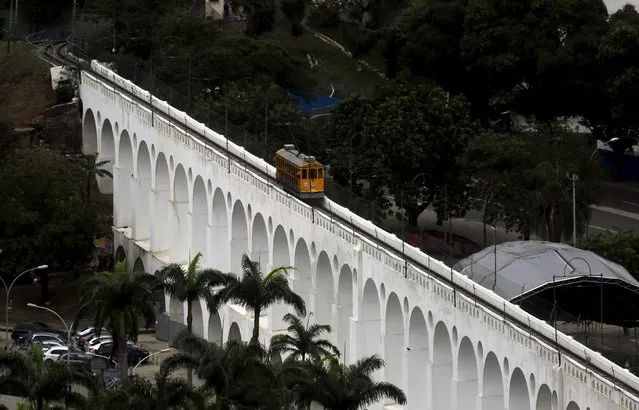
A “bonde” (tram) is seen on a line over the Arcos da Lapa (Lapa Arches), an old aqueduct from the colonial era, in the Santa Teresa neighborhood of Rio de Janeiro, Brazil, September 9, 2015. The Santa Teresa bonde, called “Bondinho” in Portuguese, is running with passengers as a part of a test period, after the service was suspended in 2011 following an accident that killed six people, according to residents. (Photo by Pilar Olivares/Reuters)
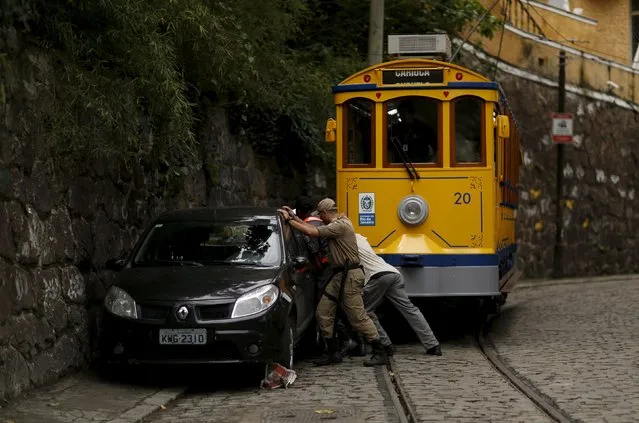
A police officer helps to move a parked car blocking the passage of a “bonde” (tram) in the Santa Teresa neighborhood of Rio de Janeiro, Brazil, September 9, 2015. (Photo by Pilar Olivares/Reuters)
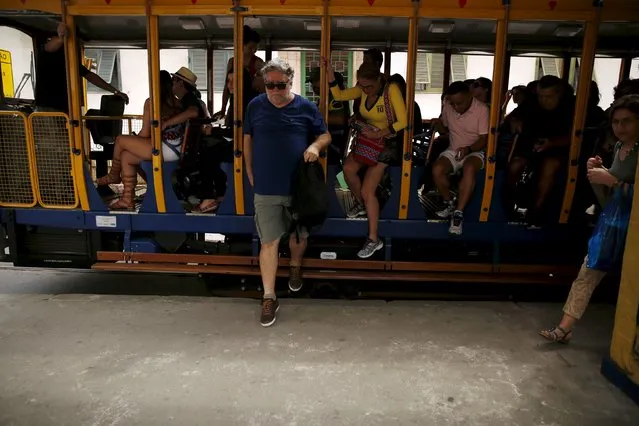
Bonde passengers disembark at the Largo do Curvelo station in Santa Teresa neighborhood in Rio de Janeiro, Brazil, September 9, 2015. (Photo by Pilar Olivares/Reuters)

Children run to board the bonde, the typical tram line in Santa Teresa neighborhood in Rio de Janeiro, Brazil, September 9, 2015. (Photo by Pilar Olivares/Reuters)

People pass a wall mural depicting a bonde, the typical tram line in Santa Teresa neighborhood in Rio de Janeiro, Brazil, September 10, 2015. (Photo by Pilar Olivares/Reuters)
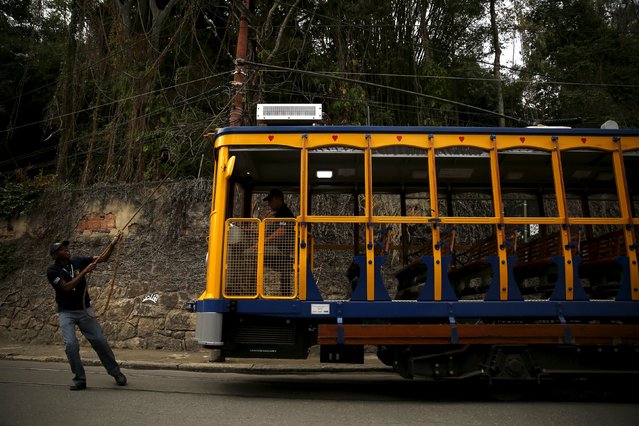
A worker manually changes the direction of the bonde, the typical tram line in Santa Teresa neighborhood, using a rope in Rio de Janeiro, Brazil, September 9, 2015. (Photo by Pilar Olivares/Reuters)
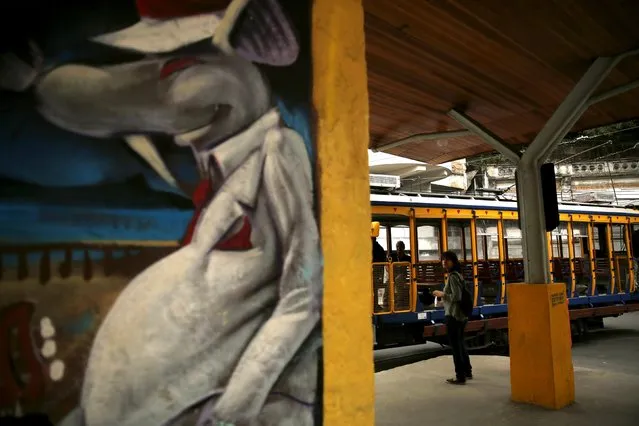
A passenger waits to board the bonde, the typical tram line in Santa Teresa neighborhood in Rio de Janeiro, Brazil, September 10, 2015. (Photo by Pilar Olivares/Reuters)
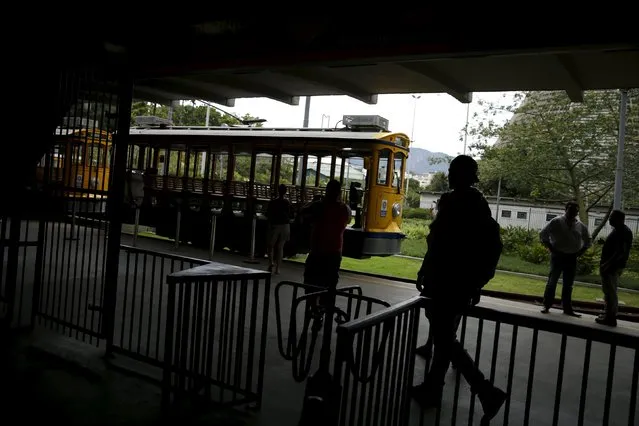
People enter a station to board the bonde, the typical tram line in Santa Teresa neighborhood in Rio de Janeiro, Brazil, September 9, 2015. (Photo by Pilar Olivares/Reuters)
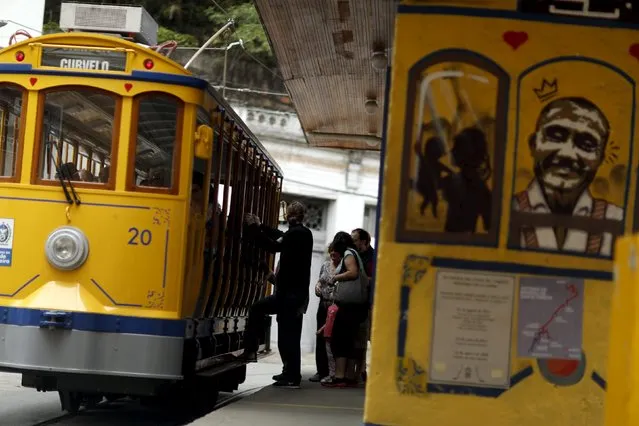
Passengers board the bonde, the typical tram line in Santa Teresa neighborhood, in Rio de Janeiro, Brazil, September 9, 2015. (Photo by Pilar Olivares/Reuters)
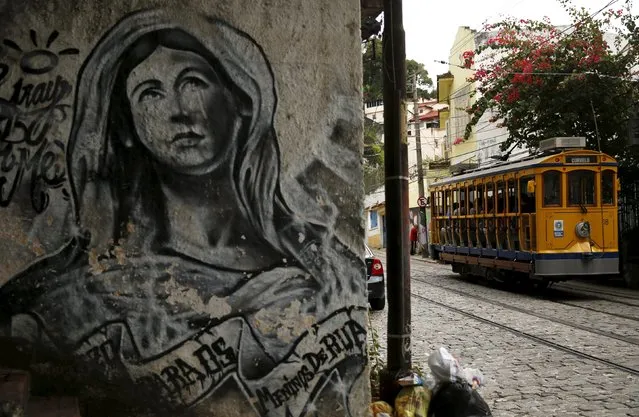
The bonde, the typical tram line in Santa Teresa neighborhood, is pictured running past graffiti in Rio de Janeiro, Brazil, September 9, 2015. (Photo by Pilar Olivares/Reuters)

A “bonde” (tram) is seen on a line over the Arcos da Lapa (Lapa Arches), an old aqueduct from the colonial era, in the Santa Teresa neighborhood of Rio de Janeiro, Brazil, September 9, 2015. The Santa Teresa bonde, called “Bondinho” in Portuguese, is running with passengers as a part of a test period, after the service was suspended in 2011 following an accident that killed six people, according to residents. (Photo by Pilar Olivares/Reuters)

A police officer helps to move a parked car blocking the passage of a “bonde” (tram) in the Santa Teresa neighborhood of Rio de Janeiro, Brazil, September 9, 2015. (Photo by Pilar Olivares/Reuters)

Bonde passengers disembark at the Largo do Curvelo station in Santa Teresa neighborhood in Rio de Janeiro, Brazil, September 9, 2015. (Photo by Pilar Olivares/Reuters)

Children run to board the bonde, the typical tram line in Santa Teresa neighborhood in Rio de Janeiro, Brazil, September 9, 2015. (Photo by Pilar Olivares/Reuters)

People pass a wall mural depicting a bonde, the typical tram line in Santa Teresa neighborhood in Rio de Janeiro, Brazil, September 10, 2015. (Photo by Pilar Olivares/Reuters)

A worker manually changes the direction of the bonde, the typical tram line in Santa Teresa neighborhood, using a rope in Rio de Janeiro, Brazil, September 9, 2015. (Photo by Pilar Olivares/Reuters)

A passenger waits to board the bonde, the typical tram line in Santa Teresa neighborhood in Rio de Janeiro, Brazil, September 10, 2015. (Photo by Pilar Olivares/Reuters)

People enter a station to board the bonde, the typical tram line in Santa Teresa neighborhood in Rio de Janeiro, Brazil, September 9, 2015. (Photo by Pilar Olivares/Reuters)

Passengers board the bonde, the typical tram line in Santa Teresa neighborhood, in Rio de Janeiro, Brazil, September 9, 2015. (Photo by Pilar Olivares/Reuters)

The bonde, the typical tram line in Santa Teresa neighborhood, is pictured running past graffiti in Rio de Janeiro, Brazil, September 9, 2015. (Photo by Pilar Olivares/Reuters)
11 Sep 2015 12:53:00,
post received
0 comments
